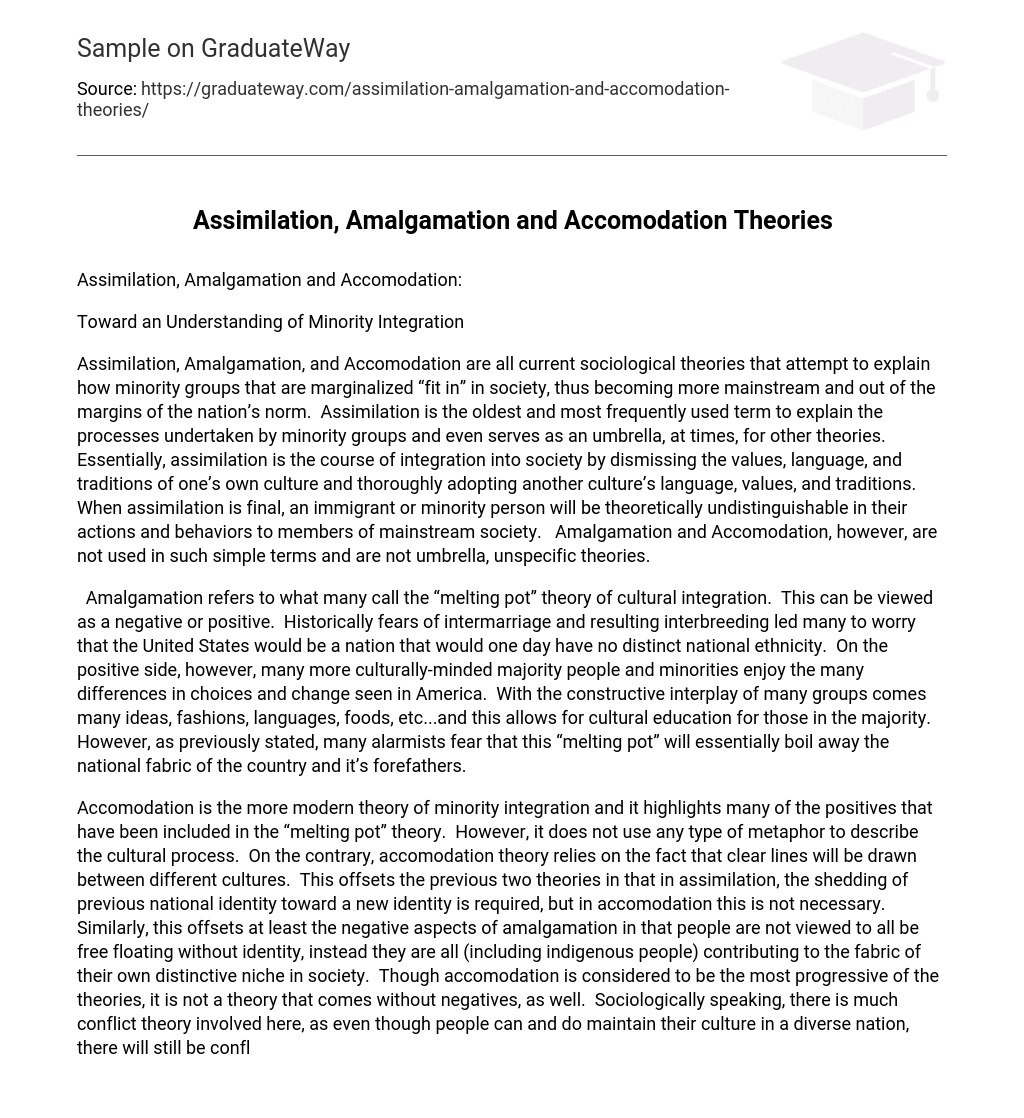Assimilation, Amalgamation, and Accomodation are all current sociological theories that attempt to explain how minority groups that are marginalized “fit in” in society, thus becoming more mainstream and out of the margins of the nation’s norm. Assimilation is the oldest and most frequently used term to explain the processes undertaken by minority groups and even serves as an umbrella, at times, for other theories.
Essentially, assimilation is the course of integration into society by dismissing the values, language, and traditions of one’s own culture and thoroughly adopting another culture’s language, values, and traditions. When assimilation is final, an immigrant or minority person will be theoretically undistinguishable in their actions and behaviors to members of mainstream society. Amalgamation and Accomodation, however, are not used in such simple terms and are not umbrella, unspecific theories.
Amalgamation refers to what many call the “melting pot” theory of cultural integration. This can be viewed as a negative or positive. Historically fears of intermarriage and resulting interbreeding led many to worry that the United States would be a nation that would one day have no distinct national ethnicity.
On the positive side, however, many more culturally-minded majority people and minorities enjoy the many differences in choices and change seen in America. With the constructive interplay of many groups comes many ideas, fashions, languages, foods, etc…and this allows for cultural education for those in the majority. However, as previously stated, many alarmists fear that this “melting pot” will essentially boil away the national fabric of the country and it’s forefathers.
Accomodation is the more modern theory of minority integration and it highlights many of the positives that have been included in the “melting pot” theory. However, it does not use any type of metaphor to describe the cultural process. On the contrary, accomodation theory relies on the fact that clear lines will be drawn between different cultures. This offsets the previous two theories in that in assimilation, the shedding of previous national identity toward a new identity is required, but in accomodation this is not necessary.
Similarly, this offsets at least the negative aspects of amalgamation in that people are not viewed to all be free floating without identity, instead they are all (including indigenous people) contributing to the fabric of their own distinctive niche in society. Though accomodation is considered to be the most progressive of the theories, it is not a theory that comes without negatives, as well. Sociologically speaking, there is much conflict theory involved here, as even though people can and do maintain their culture in a diverse nation, there will still be conflict and competition. It cannot be said, however, that conflict is not a part of many group interactions and obviously competition will be a part of the transition to any new endeavor.
In closing all three of the aforementioned theories attempt to explain the processes and problems in which minority groups attempt to become part of a new nation. Assimilation theory is the oldest and most basic umbrella theory that holds the assumption that all immigrants will eventually become “American” or whichever national group to which they live. Amalgamation is a positive and negative theory that asserts that all people minority and majority alike will change for the better or worse due to immigration influx while the newer, progressive theory of accomodation shows that change does not have to be as dramatic and essential as the other two theories insist.
References
- Parrillo, V. Understanding Race and Ethnic Relations. 3rd edition
- Steinberg, S. (2001). The Ethnic Myth: Race, Ethnicity, and Class in America. 3rd edition. Beacon Press.





